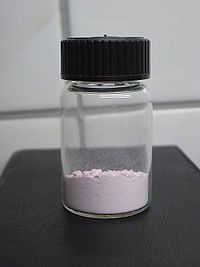- Manganese(II) chloride
-
Manganese(II) chloride 
Anhydrous
TetrahydrateManganese(II) chloride
Manganese dichlorideOther namesManganous chlorideIdentifiers CAS number 7773-01-5  , 38639-72-4 (dihydrate), 13446-34-9 (tetrahydrate)
, 38639-72-4 (dihydrate), 13446-34-9 (tetrahydrate)PubChem 24480 ChemSpider 22888 
UNII 6YB4901Y90 
ChEMBL CHEMBL1200693 
RTECS number OO9625000 Jmol-3D images Image 1 - Cl[Mn]Cl
Properties Molecular formula MnCl2 Molar mass 125.844 g/mol (anhydrous)
161.874 g/mol (dihydrate)
197.91 g/mol (tetrahydrate)Appearance pink solid (tetrahydrate) Density 2.98 g/cm3 (anhydrous)
2.27 g/cm3 (dihydrate)
2.01 g/cm3 (tetrahydrate)Melting point 654 °C (anhydrous)
dihydrate dehydrates at 135 °C
tetrahydrate dehydrates at 58 °CBoiling point 1225 °C
Solubility in water 63.4 g/100 ml (0°C)
73.9 g/100 ml (20°C)
88.5 g/100 ml (40°C)
115.0 g/100 ml (100°C)Structure Crystal structure CdCl2 Coordination
geometryoctahedral Hazards EU Index Not listed NFPA 704 Flash point Non-flammable Related compounds Other anions Manganese(II) fluoride
Manganese(II) bromide
Manganese(II) iodideOther cations Manganese(III) chloride
Technetium(IV) chloride
Rhenium(III) chloride
Rhenium(IV) chloride
Rhenium(V) chloride
Rhenium(VI) chlorideRelated compounds Chromium(II) chloride
Iron(II) chloride chloride (verify) (what is:
chloride (verify) (what is:  /
/ ?)
?)
Except where noted otherwise, data are given for materials in their standard state (at 25 °C, 100 kPa)Infobox references Manganese(II) chloride describes a series of compounds with the formula MnCl2(H2O)x, where the value of x can be 0, 2, or 4. The tetrahydrate is the most common form of "manganese(II) chloride". MnCl2·4H2O, but the anhydrous form and dihydrate MnCl2·2H2O are also known. Like many Mn(II) species, these salts are pink, the paleness of the color being characteristic of transition metal complexes with high spin d5 configurations.[1]
Contents
Preparation
Manganese chloride is produced by treating manganese(IV) oxide with concentrated hydrochloric acid.
- MnO2 + 4 HCl → MnCl2 + 2 H2O + Cl2
This reaction was once used for the manufacture of chlorine. By carefully neutralizing the resulting solution with MnCO3, one can selectively precipitate iron salts, which are common impurities in manganese dioxide.[2]
In the laboratory, manganese chloride can be prepared by treating manganese metal or manganese(II) carbonate and hydrochloric acid:
- Mn + 2 HCl → MnCl2 + H2
- MnCO3 + 2 HCl → MnCl2 + H2O + CO2
Chemical properties
Anhydrous MnCl2 is a polymeric solid, which adopts a layered cadmium chloride-like structure. The tetrahydrate consists of octahedral trans-Mn(H2O)4Cl2 molecules[3] The hydrates dissolve in water to give mildly acidic solutions with a pH of around 4.
It is a weak Lewis acid, reacting with chloride ions to produce a series of solids containing the following ions [MnCl3]−, [MnCl4]2−, and [MnCl6]4−. Both [MnCl3]− and [MnCl4]2− are polymeric.
Upon treatment with typical organic ligands, manganese(II) undergoes oxidation by air to give Mn(III) complexes. Examples include [Mn(EDTA)]−, [Mn(CN)6]3−, and [Mn(acetylacetonate)3]. Triphenylphosphine forms a labile 2:1 adduct:
- MnCl2 + 2 Ph3P → [MnCl2(Ph3P)2]
Anhydrous manganese(II) chloride serves as a starting point for the synthesis of a variety of manganese compounds. For example, manganocene is prepared by reaction of MnCl2 with a solution of sodium cyclopentadienide in THF.
- MnCl2 + 2 NaC5H5 → Mn(C5H5)2 + 2 NaCl
Applications
The main application is used in the production of dry cell batteries. It is the precursor to the antiknock compound methylcyclopentadienyl manganese tricarbonyl.[2]
Vesicle characterization with 31P-NMR
MnCl2 is used in 31P-NMR to determine the size and lamellarity of phospholipid vesicles.[4] When manganese chloride is added to a vesicular solution, Mn2+ paramagnetic ions are released, perturbing the relaxation time of the phospholipids' phosphate groups and broadening the resulting 31P resonance signal. Only phospholipids located in the outermost monolayer exposed to Mn2+ experience this broadening. The effect is negligle for multilamellar vesicles, but for large unilamellar vesicles, a ~50% reduction in signal intensity is observed.[5]
Precautions
Manganism, or manganese poisoning, can be caused by long-term exposure to manganese dust or fumes.
References
- ^ N. N. Greenwood, A. Earnshaw, Chemistry of the Elements, 2nd ed., Butterworth-Heinemann, Oxford, UK, 1997.
- ^ a b Reidies, Arno H. (2002), "Manganese Compounds", Ullmann's Encyclopedia of Industrial Chemistry, Weinheim: Wiley-VCH, doi:10.1002/14356007.a16_123, ISBN 3-527-30385-5.
- '^ A. F. Wells, Structural Inorganic Chemistry, 5th ed., Oxford University Press, Oxford, UK, 1984.
- ^ Frohlich, Margret; Brecht, Volker; Peschka-Suss, Regine (January 2001), "Parameters influencing the determination of liposome lamellarity by 31P-NMR", Chemistry and Physics of Lipids 109 (1): 103–112, doi:10.1016/S0009-3084(00)00220-6, PMID 11163348, http://www.sciencedirect.com/science?_ob=ArticleURL&_udi=B6T2N-423J9WK-9&_user=10&_coverDate=01/31/2001&_rdoc=1&_fmt=high&_orig=search&_origin=search&_sort=d&_docanchor=&view=c&_searchStrId=1527591417&_rerunOrigin=google&_acct=C000050221&_version=1&_urlVersion=0&_userid=10&md5=7433836d10ceaa1aee850a98fefa62dd&searchtype=a
- ^ Hope, M; Bally, M; Webb, G; Cullis, P (received = April 10, 1984), "Production of large unilamellar vesicles by a rapid extrusion procedure. Characterization of size distribution, trapped volume and ability to maintain a membrane potential", Biochimica et Biophysica Acta 812: 55–65, doi:10.1016/0005-2736(85)90521-8, http://www.islandnet.com/~prc/PDFs/073.pdf
External links
Manganese compounds Categories:- Chlorides
- Manganese compounds
- Metal halides
Wikimedia Foundation. 2010.

